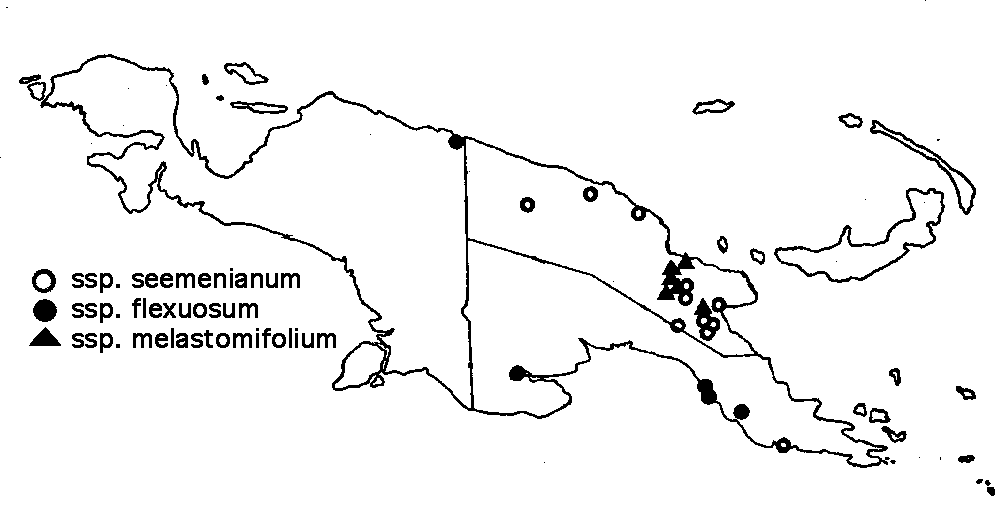
Distribution Map

Description (Barlow 1992)
Loranthus seemenianus Schumann in Schumann & Hollrung, Fl. Kaiser Wilh. Land (1889) 106. Amyema seemeniana (Schumann) Danser, Bull. Jard. Bot. Buitenzorg III, 10 (1929) 299. - Type: Hollrung 345 (lecto K, see below; iso WRSL), New Guinea, near Hatzfeldhafen, x.1886.
For descriptions and further. synonymy see Barlow, Austral. J. Bot. 22 (1974) 589; Flora of Australia 22 (1984) 122; Danser, Bull. Jard. Bot. Buitenzorg III, 11 (1931) 320, 338, 345, under A. articulata, A. melastomifolia and A. seemeniana. Along with the closely related and sympatric A. squarrosa, the species is distinct from most of its congeners in its inflorescence which is a slender, pedunculate, 2-flowered simple umbel, bearing flowers with a thin inflated corolla in which the petals may remain coherent for some time after anthesis. Amyema seemeniana can be distinguished from A. squarrosa by its more curvinerved leaves and distinctinflorescence peduncle more than 2 mm long. The flower colour is variable, mostly described as various shades of red from pale pink to dark red, or of pale to dark orange, and occasionally of yellow or green or almost white, frequently having the orange or red colours in the lower part and being paler, or green, or yellow above.
The species is common in New Guinea (fig. 13; 60 collections seen),
at elevations from sea level to 2150 m, in primary and secondary
rain forests, parasitic on numerous hosts including Acalypha,
Albizia, Ficus, /lex, Nauclea, Planchonella, Psychotria, Sarcocephalus,
and Xanthophyllum. It also occurs in Cape York Peninsula,
Queensland.
The reduced inflorescence is probably a parallel development to
other simple umbels in the genus (see notes under Amyema above
and under A. fasciculata and A. sanguinea). Amyema seemeniana
comprises three subspecies, seemeniana, flexuosa Barlow
and melastomifolia (Krause) Barlow, which differ in qualitative
and quantitative floral characters and in leaf size, and have
strong geographic and altitudinal separation.
The holotype of Loranthus seemenianus (B) is no longer
extant. An isotype in K has been seen and designated lectotype
of the name. An isotype in WRSL has also been seen.
For note on the possible identity of the doubtful species A. curvifolia, see note under A. hastifolia.
Description (Barlow 1974)
Amyema seemenianum (Schum.) Dans. Bull. Jard. bot. Buitenz. 10: 299 (1929); 11: 345, illus. Fig. 11,f-h (1931); Loranthus seemenianus Schum. in Schum. & Hollr. Fl. Kais. Wilh. Ld. 106 (1889). Type-New Guinea, shore near Hatzfeldhafen, Hollrung 345, Oct. 1886 (B, holotype, not seen, probably destroyed; K; WRSK).
Loranthus articulatus Krause, Bot. Jahrb. 57: 485 (1922); Amyema articulata (Krause) Dans. Bull. Jard. bot. Buitenz. 10: 293 (1929); 11: 322, illus. Fig. 9, a (1931). Type-New Guinea, Keneyia R., 150 m alt., Schlechter 18380, 12.x.1908 (B, holotype, not seen, probably destroyed; P; UC 226803).
Loranthus melastomatifolius Krause, Bot. Jahrb. 57: 465, 488 (1922); Amyema melastomatifolia Dans. Bull. Jard. bot. Buitenz. 10: 297 (1929); 11: 338, illus. Fig. 10, m (1931). Type-New Guinea, Kani Mountains, 1000 m alt., Schlechter 17809, 17.i.1908 (B, holotype, not seen, probably destroyed; uc 226506).
Glabrous or the inflorescences and flowers shortly and sparsely to densely brown-or white-tomentose. Leaves opposite; petiole flat or channelled above, 5-18 mm long; lamina broad lanceolate to broad ovate, 6-30 by (3)-5-13 cm, abruptly attenuate at the base, obtuse or acute and acuminate at the apex; venation curvinerved with 3 or 5 veins distinct on both sides. Inflorescences few to several at the nodes, each consisting of a 2-flowered simple umbel; peduncle 3-8 mm long, c. 0.5 mm thick, with a small flange at the apex; rays (2)-3-6 mm long, almost as thick as the peduncle; bracts membranous, distinct, spreading, rounded, 1-2 mm long. Calyx cylindrical to funnel-shaped; limb variable (obscure to distinct and membranous, 0.2-2.0 mm long). Corolla in the mature bud thin, curved, more or less inflated, not clavate, acute obtuse or rounded at the apex, 30-65 mm long; petals in the open flower usually 5, often remaining coherent for some time but eventually separating irregul-arly to the base. Anthers 5-7 mm long, nearly equal to the free parts of the filaments.
Stigma 1-1.5 times as wide as the style. Fruit pear-shaped to nearly globular, constricted at the apex and crowned by the calyx limb. (Fig. 5, q.)
Occurrence. New Guinea, from Hollandia to the Sogeri Plateau (Fig. 6), sea level to 2150 m altitude. Also recorded from Cape York Peninsula, Queensland.
Amyema seemenianum is very closely related to A. squarrosum (see note under A. squarrosum), and these two species together form a complex within which several distinct forms may be recognized. The variation within A. seemenianum is such that three relatively distinct subspecies are separable. The spatial separation of the subspecies is both altitudinal and geographical.
Key to Subspecies of Amyema seemeniarnim
1. Anthers strongly curved or hooked at the
end. Calyx funnel-shaped, tawny in colour but with a dense white
tomentum; limb short, irregular, usually folded inwards. Lamina
mostly acute and acuminate, up to 12 cm long 24c. Subsp. flexuosum
1. Anthers slightly curved or
straight. Calyx cylindrical, cup-shaped or funnel-shaped, pale-
or dark-coloured, glabrous or white- to brown-tomentose; limb
distinct, membranous, more than 1 mm long 2
2. Lamina up to 10 cm long, acute or obtuse, not acuminate. Corolla
up to 35 mm long. Inflorescence calyx and corolla glabrous
or tomentose. Calyx contracted below the limb; limb flaring, conspicuous
24a. Subsp. seemenianum
2. Lamina up to 30 cm long,
acute and acuminate. Corolla up to 65 mm long. Inflorescence
calyx and corolla shortly and sparsely tomentose. Calyx cylindrical
or cup-shaped, not constricted, limb erect 24b. Subsp. melastomifolium
24a. Subsp. seemenianum
Loranthus articulatus Krause; Amyema articulata (Krause) Dans. Illus. Dans. Bull. Jard. bot. Buitenz. 11: 343, Fig. 11, f-h (1931).
Inflorescence, calyx and corolla glabrous or tomentose. Lamina up to 10 cm long, acute or obtuse at the apex but not acuminate. Calyx cylindrical or funnel-shaped, contracted below the limb; limb distinct, membranous, flaring, 1-2.5 mm long. Corolla in the mature bud 30-35 mm long. Anthers slightly curved or straight. (Fig. 5, q.) Chromosome Number. n = 9 (Barlow and Wiens 1971). Voucher: Barlow 952.
Occurrence. North-eastern New Guinea, from Hatzfeldhafen to Wau (Fig. 6), sea level to 1100 m altitude. The subspecies is common on introduced hosts in settled areas as well as on a variety of rain-forest trees.
Representative Specimens. EASTERN NEW GUINEA: Umi R., Markham Valley, 480 m alt., Brass 32559, 16.xi.1959 (CANB; K; L); road to McAdam Park, near Wau, 1100m alt., Barlow 952, 11.ii.1965 (BRIU; L; LAE).
Specimens from the lowlands are mostly glabrous, whereas those from higher altitudes (Bulolo-Wau area) have tomentose inflorescences and flowers. In this respect the subspecies shows a gradation into subsp. melastomifolium of higher altitudes. although in other diagnostic characters the two subspecies are distinct.
24b. Subsp. melastomifolium (Krause) Barlow, comb. et stat. nov.
Loranthus melastomatifolius Krause, Bot. Jahrb. 57: 465, 488 (1922). Amyema melastomifolia (Krause) Dans. Bull. Jard. bot. Buitenz. 10: 207 (1929); 11: 338, illus. Fig. 10, m (1931). Type-New Guinea, Kani Mts., 1000 m alt., Schlechter 17809, 17.i.1908 (B, holotype, not seen, probably destroyed; uc 226506).
Inflorescence, calyx and corolla shortly and sparsely tomentose. Lamina up to 30 cm long, acute and acuminate at the apex. Calyx cylindrical or cup-shaped, not constricted; limb distinct, membranous, erect, 1-2 mm long. Corolla in the mature bud 40-65 mm long. Anthers slightly curved or straight.
Occurrence. North-eastern New Guinea, from Saidor Subdistrict to the Eastern Highlands (Fig. 6), 1000 to 2150 in altitude. The subspecies thus occurs in the same geographic area as subsp. seemenianum, but at higher altitudes.
Representative Specimens. EASTERN NEW GUINEA: Sewe, Saidor Subdist., Madang Dist., 2150 m alt., Sayers NGF 19783, 11.vii.1964 (LAE); 2 miles W. of Omaura, Eastern Highlands, Hartley 11954, 3.vii.1963 (CANB; L).
See note under subsp. seemenianum.
24c. Subsp. flexuosum Barlow, subsp. nov.
Type-Central N. coast of Yule I., Papua, c. 3 m alt., Darbyshire 743, 31.vii.1962 (CANB 114353, holotype; CANB 114354; L 961136875).
Folia pleruinque acuta acuminataque, ad 12
cm longa. Calyx infundibuliformis, fulvus colore sed dense albotomentosus;
limbus brevis, irregularis, plerumque incurvus. Antherae apice
valde flexuosae vel hamatae.
Calyx densely white-tomentose. Lamina up to 12 cm long, mostly
acute and acuminate at the apex. Calyx funnel-shaped, tawny in
colour; limb short, irregular, usually folded inwards. Anthers
strongly curved or hooked at the end. Chromosome Number.- n
= 9 (Barlow 1964 under A. seemenianum).
Occurrence. New Guinea, from Fly R. to Sogeri Plateau (Fig. 6), sea level to 480 in altitude. Also Hollandia (Fig. 6), near sea level. The subspecies is common on introduced hosts in settled areas.
Representative Specimens. WEST IRIAN: Hamadi near
Hollandia, 0 m alt., Iwanggin BW 5221, 29.i.1957 (CANB).
EASTERN NEW GUINEA: Lower Fly R., E. bank opposite Sturt
I., Brass 7990, Oct. 1936 (L); Musgrave Valley, Sogeri
Plateau, 450 m alt., Barlow 983, 22.ii.1965 (BRIU;
AD; LP LAE).
Illustrations
|
|
|
|
Amyema seemenianum (as A. articulata). Twig with your fruit. From Danser (1931). |
Amyema seemenianum ssp. melastomifolia (as A. melastomifolia). Inflorescence. From Danser (1931). |
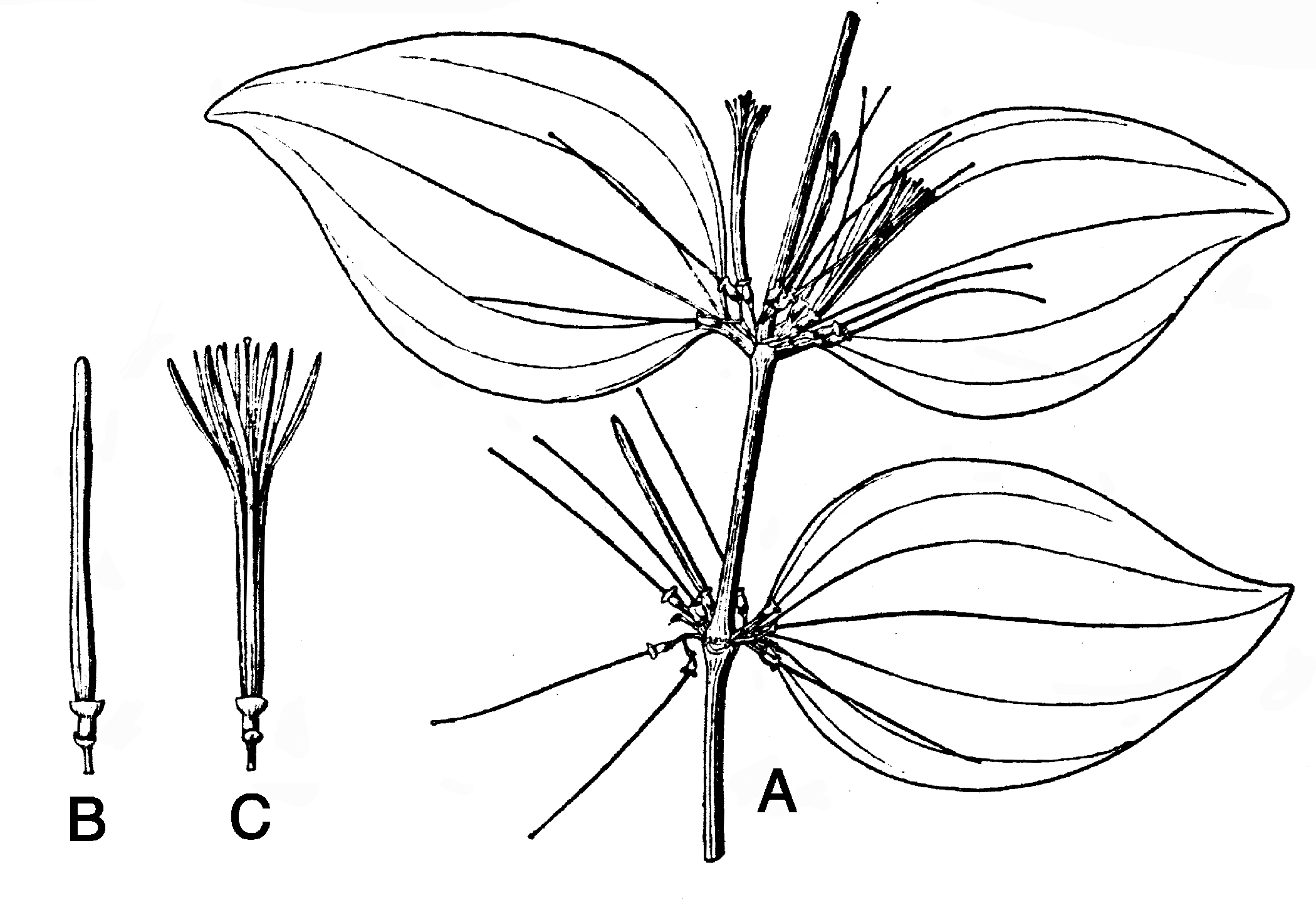
Amyema seemenianum. A - flower-bearing twig. B - flower bud. C - flower. From Danser (1931).
|
|
|
|
Amyema seemenianum subsp. seemenianum. Node showing inflorescences. From Barlow (1974). |
Inflorescence a 2-rayed simple umbel. Schodde 3117, L. From Kuijt (1981). |
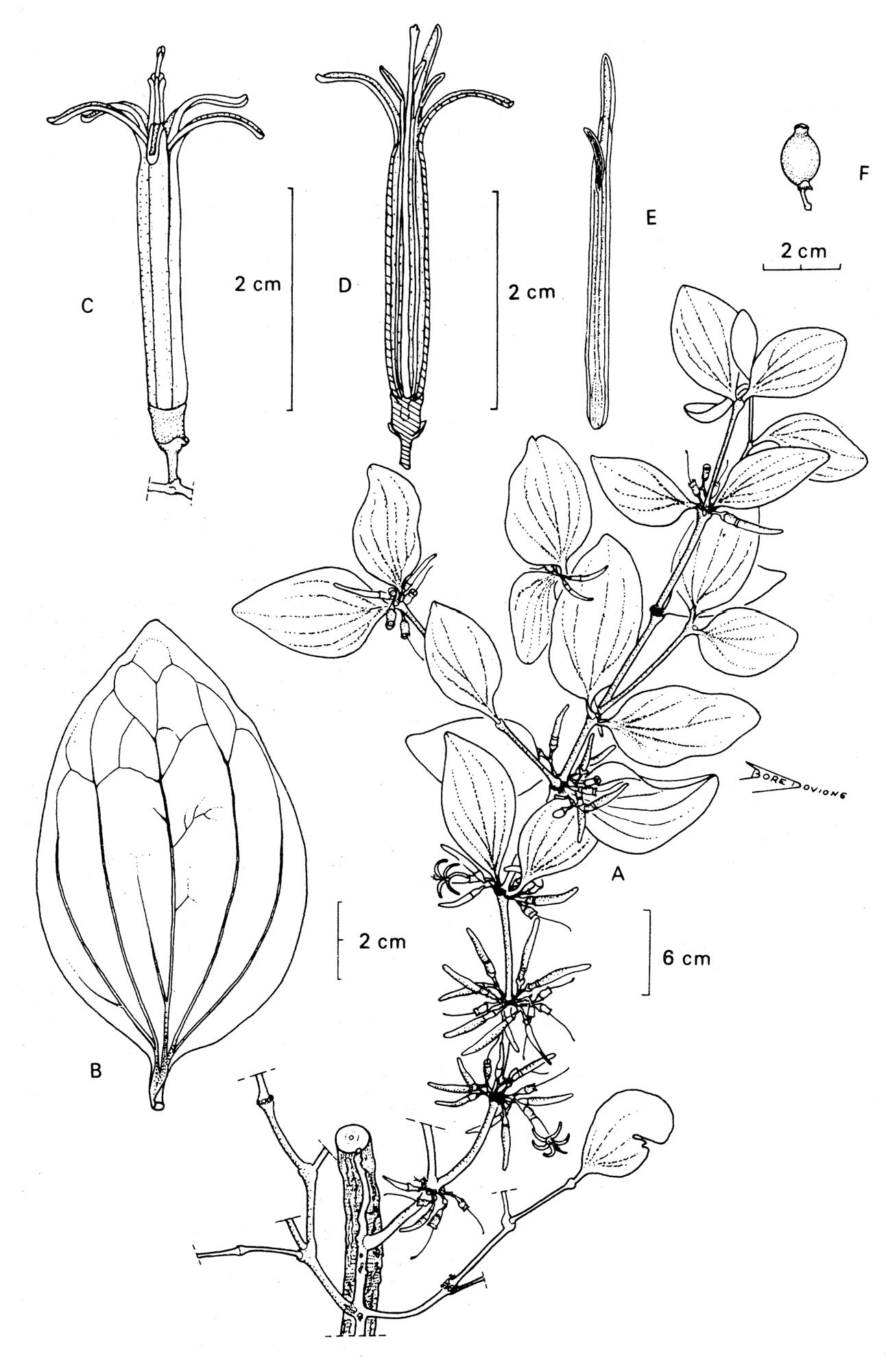
Amyema seemeniana. A - flowering and fruiting plant. B - leaf. C - flower. D - longitudinal section of flower. E - petal with stamens. F - Fruit. From Barlow (1981).
Photographs
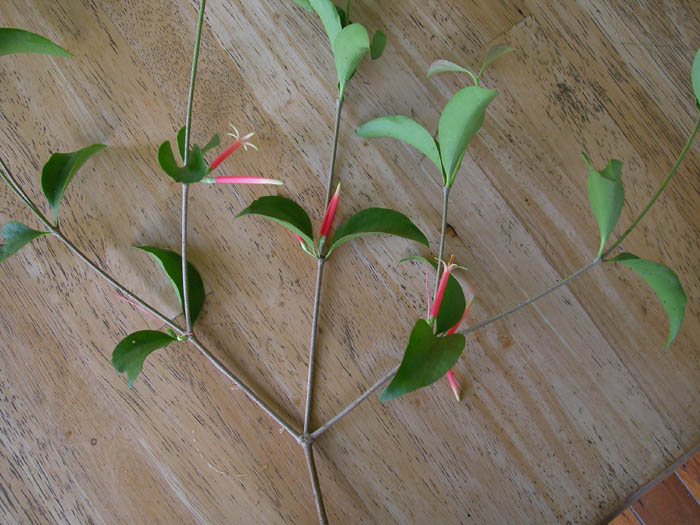
Flowering shoots above and close-up of flowers below (both DLN 4463). Morobe District, Lae, UNITECH campus, Papua New Guinea. Photo by D. L. Nickrent.
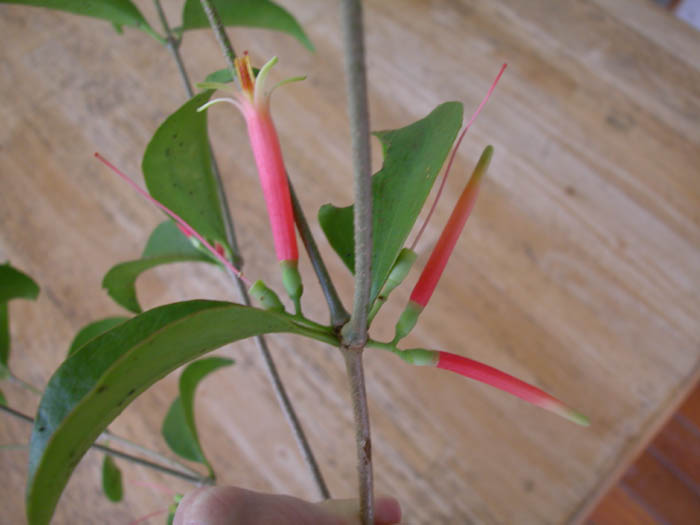
Amyema seemeniana
updated 20 January 2007